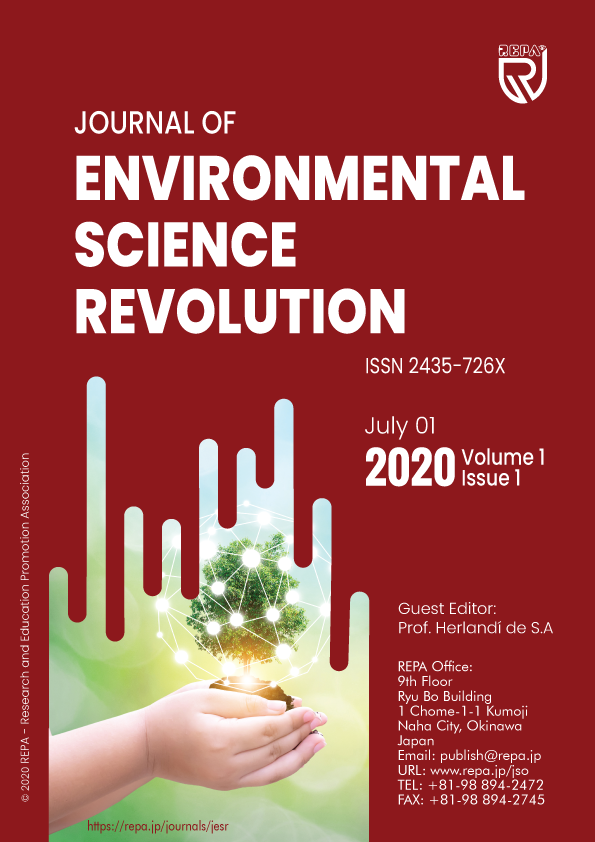⇒ Volume Number: 01
⇒ Issue Number: 01
⇒ Available Online: June 30, 2020
⇒ Volume Editor: Prof. Herlandí de Souza Andrade, University of São Paulo, Brazil
⇒ Issue Editor: Editorial Office, Research and Education Promotion Association (REPA), Japan
⇒ Language and Proofreading Editor: Prof. Emil Chuck, George Mason University, USA
⇒ Copyeditor: Ms. Barnes K. and Ms. Sarah A., Research and Education Promotion Association (REPA), Japan
⇒ Administrator: Ms. Michell Ann., Research and Education Promotion Association (REPA), Japan
Journal Article (Special Issue) Open Access Published 
Evaluating stream bank instability and toe erosion using BSTEM model for the Amu river
Rasouli MO, Sadat SH, and Xenarios S.
Journal of Environmental Sciences Revolution, 2020, 1 (1): 1-6 DOI 10.37357/1068/jesr.1.1.01
Loss of land, disputes on sharing costs, and benefits of transboundary waterways are points of debate between neighboring countries. Unfortunately, weak, undeveloped countries always suffer more than their stronger neighbors. Due to economic, political, and institutional problems, Afghanistan is one country that faces challenges to develop the potential of its water resources. Each year, Amu River flooding causes great losses of land due to massive bank degradations and erosions for up to several kilometers. Currently little progress has been made to study, research, or manage the bank erosions of the Amu River. In the absence of field data, the Bank Stability and Toe Erosion Model (BSTEM) may be used to analyze stream bank stability and toe erosion. This study was conducted to describe the Amu River stream bank using the BSTEM model for a restoration process. A field survey was conducted from February 3, 2019, to February 23, 2019; soil type, layer thickness, water table depth, and stream bank profile are entered into the BSTEM model with two different flow depths according to insights from villagers and well-diggers. Mass failure and toe erosion are two dominant mechanisms of Amu River bank failure, and the effectiveness of vegetation on bank protection is observed.
REPA
Rasouli MO, Sadat SH, Xenarios S (2020) “Evaluating stream bank instability and toe erosion using BSTEM model for the Amu river” Journal of Environmental Science Revolution (vol. 1, no. 1, pp. 1–6) https://doi.org/10.37357/1068/jesr/1.1.01
APA
Rasouli, M. O., Sadat, S. H., & Xenarios, S. (2020). Evaluating stream bank instability and toe erosion using BSTEM model for the Amu river. Journal of Environmental Sciences Revolution, 1(1), 1–6. https://doi.org/10.37357/1068/jesr/1.1.01
MLA
Rasouli, Mohammad Omar, et al. “Evaluating Stream Bank Instability and Toe Erosion Using BSTEM Model for the Amu River.” Journal of Environmental Sciences Revolution, vol. 1, no. 1, 2020, pp. 1–6, doi:10.37357/1068/jesr/1.1.01.
Vancouver
Rasouli MO, Sadat SH, Xenarios S. Evaluating stream bank instability and toe erosion using BSTEM model for the Amu river. J Environ Sci Rev. 2020;1(1):1–6.
Chicago
Rasouli, Mohammad Omar, Sayed Hashmat Sadat, and Stefanos Xenarios. 2020. “Evaluating Stream Bank Instability and Toe Erosion Using BSTEM Model for the Amu River.” Journal of Environmental Sciences Revolution 1 (1): 1–6. https://doi.org/10.37357/1068/jesr/1.1.01.
Elsevier
Rasouli, M.O., Sadat, S.H., Xenarios, S., 2020. Evaluating stream bank instability and toe erosion using BSTEM model for the Amu river. J. Environ. Sci. Rev. 1, 1–6. https://doi.org/10.37357/1068/jesr/1.1.01
IEEE
- O. Rasouli, S. H. Sadat, and S. Xenarios, “Evaluating stream bank instability and toe erosion using BSTEM model for the Amu river,” J. Environ. Sci. Rev., vol. 1, no. 1, pp. 1–6, 2020, doi: 10.37357/1068/jesr/1.1.01.
Springer
Rasouli, M.O., Sadat, S.H., Xenarios, S.: Evaluating stream bank instability and toe erosion using BSTEM model for the Amu river. J. Environ. Sci. Rev. 1, 1–6 (2020). https://doi.org/10.37357/1068/jesr/1.1.01.
Mohammad Omar Rasouli
Department Department of Civil Engineering, Faculty of Engineering, Kabul University, Kabul, Afghanistan
Sayed Hashmat Sadat
Department Department of Civil Engineering, Faculty of Engineering, Kabul University, Kabul, Afghanistan
Stefanos Xenarios
Graduate School of Public Policy, Nazarbayev University, Astana, Kazakhstan
-
Lavendel B (2002) “The Business of Ecological Restoration” Ecological Restoration (vol. 20, no. 3, pp. 173–178)
-
Bernhardt ES, Palmer MA, Allan JD, Alexander G, Barnas K, et al. (2005) “Synthesizing U.S. River Restoration Efforts” Science (vol. 308, no. 5722, pp. 636–637) https://doi.org/10.1126/science.1109769
-
Sadat SH (2015) “Modification of spur-dike with footing or pile-group to stabilize river morphology and reduce local scour” (PhD Dissertation) Nagoya, Japan, Nagoya Institute of Technology (https://nitech.repo.nii.ac.jp/?action=repository_action_common_download&item_id=3168&item_no=1&attribute_id=13&file_no=2) Accessed: 1 November 2019
-
Langendoen Eddy J., Simon Andrew (2008) “Modeling the Evolution of Incised Streams: Streambank Erosion (Part 2)” Journal of Hydraulic Engineering (vol. 134, no. 7, pp. 905–915) https://doi.org/10.1061/(ASCE)0733-9429(2008)134:7(905)
-
Reisner DE, Pradeep T, Pradeep T (2014) “Aquananotechnology: Global Prospects,” 1st ed. Florida, United States, CRC Press. 887 p. ISBN: 978-0-429-18563-2 (https://www.taylorfrancis.com/books/e/9780429185632) Accessed: 1 November 2019
-
Simon A, Curini A, Darby SE, Langendoen EJ (2000) “Bank and near-bank processes in an incised channel” Geomorphology (vol. 35, no. 3, pp. 193–217) https://doi.org/10.1016/S0169-555X(00)00036-2
-
Location of study area in Amu river (2018) (https://landlook.usgs.gov/viewer.html) Accessed: 27 June 2018
-
Land Cover, Afghanistan (FAO) (2010) Food and Agriculture Organization (FAO) (http://www.un-spider.org/links-and-resources/data-sources/land-cover-afghanistan-fao) Accessed: 1 November 2019
-
Ariathurai R, Arulanandan K (1978) “Erosion Rates of Cohesive Soils” Journal of the Hydraulics Division (vol. 104, no. 2, pp. 279–283)
-
Klavon K, Fox G, Guertault L, Langendoen E, Enlow H, et al. (2017) “Evaluating a process-based model for use in streambank stabilization: insights on the Bank Stability and Toe Erosion Model (BSTEM)” Earth Surface Processes and Landforms (vol. 42, no. 1, pp. 191–213) https://doi.org/10.1002/esp.4073
-
Hanson GJ, Simon A (2001) “Erodibility of cohesive streambeds in the loess area of the midwestern USA” Hydrological Processes (vol. 15, no. 1, pp. 23–38) https://doi.org/10.1002/hyp.149
The author(s) has received no specific funding for this article/publication.
Journal Article (Special Issue) Open Access Published
Climate change impact on glacier lakes in Panjshir province of Afghanistan
Sajood MK, and Safi AG.
Journal of Environmental Sciences Revolution, 2020, 1 (1): 7-17 DOI 10.37357/1068/jesr.1.1.02
The upper portion of the Panjshir River watershed consists of steep mountain valleys in the Hindu Kush mountain range, which reaches over 6,000 meters above sea level and remains snow covered throughout the year. The Glacier Lakes there pose a potential flood risk to the Panjshir valley. As the weather is warming globally, the increasing temperatures accelerate the melting rate of the glacier, causing the mountain ice caps to melt and create numerous lakes. Over the last decade, two of these lakes ruptured, leaving dozens of deaths, many hectares of land farm washed out, and hundreds of houses destroyed. This study looks at the potential impact of climate change on villagers in the province. Hydro-meteorological data (wind, temperature, precipitation, and runoff) from five meteorological stations over the last decade were analyzed with satellite imagery. Discharge data at the outlet of this sub-basin over ten years were also analyzed with remote sensing data for higher accuracy and validity. Rising regional climate temperatures have resulted in faster snow and glacier melting, causing more discharge, high evapotranspiration, and higher water demand. Although precipitation decreased between 2008 and 2018, discharge increased from melting glaciers. Satellite imagery reveals 234 lakes in the valley; 66 lakes have potential or high potential risk to the six districts of this province, and Paryan district is at most risk.
REPA
Sajood MK, Safi AG (2020) “Climate change impact on glacier lakes in Panjshir province of Afghanistan” Journal of Environmental Science Revolution (vol. 1, no. 1, pp. 7–17) https://doi.org/10.37357/1068/jesr/1.1.02
APA
Sajood, M. K., & Safi, A. G. (2020). Climate change impact on glacier lakes in Panjshir province of Afghanistan. Journal of Environmental Sciences Revolution, 1(1), 7–17. https://doi.org/10.37357/1068/jesr/1.1.02
MLA
Sajood, Mariam Khulmi, and Abdul Ghias Safi. “Climate Change Impact on Glacier Lakes in Panjshir Province of Afghanistan.” Journal of Environmental Sciences Revolution, vol. 1, no. 1, 2020, pp. 7–17, doi:10.37357/1068/jesr/1.1.02.
Vancouver
Sajood MK, Safi AG. Climate change impact on glacier lakes in Panjshir province of Afghanistan. J Environ Sci Rev. 2020;1(1):7–17.
Chicago
Sajood, Mariam Khulmi, and Abdul Ghias Safi. 2020. “Climate Change Impact on Glacier Lakes in Panjshir Province of Afghanistan.” Journal of Environmental Sciences Revolution 1 (1): 7–17. https://doi.org/10.37357/1068/jesr/1.1.02.
Elsevier
Sajood, M.K., Safi, A.G., 2020. Climate change impact on glacier lakes in Panjshir province of Afghanistan. J. Environ. Sci. Rev. 1, 7–17. https://doi.org/10.37357/1068/jesr/1.1.02
IEEE
- K. Sajood and A. G. Safi, “Climate change impact on glacier lakes in Panjshir province of Afghanistan,” J. Environ. Sci. Rev., vol. 1, no. 1, pp. 7–17, 2020, doi: 10.37357/1068/jesr/1.1.02.
Springer
Sajood, M.K., Safi, A.G.: Climate change impact on glacier lakes in Panjshir province of Afghanistan. J. Environ. Sci. Rev. 1, 7–17 (2020). https://doi.org/10.37357/1068/jesr/1.1.02.
Mariam Khulmi Sajood
Department of Hydrometeorology, Faculty of Geoscience, Kabul University, Kabul, Afghanistan
Abdul Ghias Safi
Department of Hydrometeorology, Faculty of Geoscience, Kabul University, Kabul, Afghanistan
-
Arez GJ (2007) “Afghanistan natural geography” Kabul University (vol. 1, no. 1, pp. 59–71)
-
Mir RA, Jain SK, Lohani AK, Saraf AK (2018) “Glacier recession and glacial lake outburst flood studies in Zanskar basin, western Himalaya” Journal of Hydrology (vol. 564, pp. 376–396) https://doi.org/10.1016/j.jhydrol.2018.05.031
-
Drenkhan F, Guardamino L, Huggel C, Frey H (2018) “Current and future glacier and lake assessment in the deglaciating Vilcanota-Urubamba basin, Peruvian Andes” Global and Planetary Change (vol. 169, pp. 105–118) https://doi.org/10.1016/j.gloplacha.2018.07.005
-
Puspitarini HD, François B, Zaramella M, Brown C, Borga M (2020) “The impact of glacier shrinkage on energy production from hydropower-solar complementarity in alpine river basins” Science of The Total Environment (vol. 719, pp. 137488) https://doi.org/10.1016/j.scitotenv.2020.137488
-
Carrivick JL, Tweed FS (2019) “A review of glacier outburst floods in Iceland and Greenland with a megafloods perspective” Earth-Science Reviews (vol. 196, pp. 102876) https://doi.org/10.1016/j.earscirev.2019.102876
-
Sun J, Zhou T, Liu M, Chen Y, Shang H, et al. (2018) “Linkages of the dynamics of glaciers and lakes with the climate elements over the Tibetan Plateau” Earth-Science Reviews (vol. 185, pp. 308–324) https://doi.org/10.1016/j.earscirev.2018.06.012
-
Shrestha M, Koike T, Hirabayashi Y, Xue Y, Wang L, et al. (2015) “Integrated simulation of snow and glacier melt in water and energy balance-based, distributed hydrological modeling framework at Hunza River Basin of Pakistan Karakoram region” Journal of Geophysical Research: Atmospheres (vol. 120, no. 10, pp. 4889–4919) https://doi.org/10.1002/2014JD022666
-
Taniwal MZ (2018) “Afghanistan general geography” Karwan University (vol. 59, )
-
Sajood MK (2019) “DEM (ASTER satellite imagery); ET (Evapotranspiration), LST (Temperature) and Precipitation – Monthly satellite imagery” (https://worldview.earthdata.nasa.gov/) Accessed: 1 November 2019
-
Veh G, Korup O, Walz A (2020) “Hazard from Himalayan glacier lake outburst floods” Proceedings of the National Academy of Sciences (vol. 117, no. 2, pp. 907–912) https://doi.org/10.1073/pnas.1914898117
-
Ministry of Energy and Water (MEW) - Afghanistan (2018) “Afghanistan agrometeorological bulleting” (http://mew.gov.af/) Accessed: 1 November 2019
-
Ministry of Energy and Water (MEW) - Afghanistan (2018) “Hydrological data” (http://mew.gov.af/) Accessed: 1 November 2019
The author(s) has received no specific funding for this article/publication.



